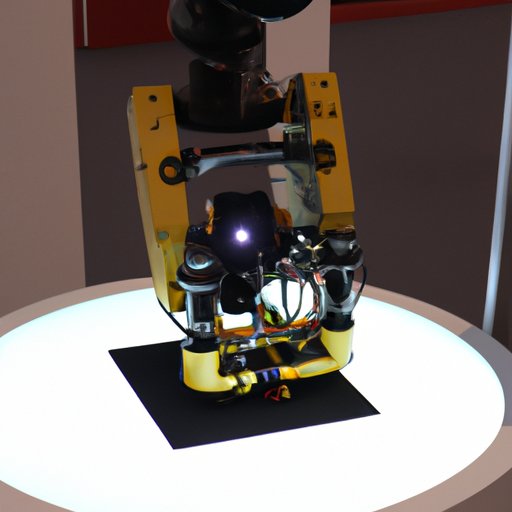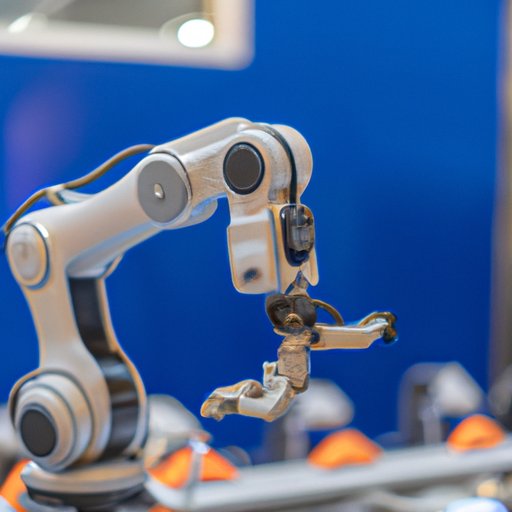Introduction
Robotic engineering is a rapidly growing field with a wide range of applications. It involves the design, construction, operation, and use of robots in various industries. In this article, we will explore the history, applications, and future of robotics and how it is used in automation and manufacturing.

Overview of Robotic Engineering and Its Applications
Robotic engineering is the science of designing, constructing, and operating robots. It also includes the study of control systems, artificial intelligence, and computer vision. Robots are machines that can be programmed to carry out specific tasks autonomously or semi-autonomously. They have been used for a variety of purposes, including manufacturing, space exploration, medical diagnostics, and search and rescue operations.
Robots have become increasingly sophisticated over time, with more advanced models capable of performing complex tasks such as surgery, welding, painting, and even cleaning. They are also used in military applications, such as bomb disposal and reconnaissance. The applications of robotics are constantly evolving, with new technologies being developed every day.

The History and Evolution of Robotics
The history of robotics dates back to ancient times, when people began constructing mechanical devices powered by steam or water. The first modern robot was created in 1954 by George Devol, who invented the Unimate, a robot arm that could be programmed to perform certain tasks. Since then, robots have become increasingly sophisticated, with advances in technology allowing them to perform more complex tasks.
In the 1970s, robots began to be used in industrial settings, such as factories and warehouses. This marked the beginning of automation, which has since become an integral part of many industries. Today, robots are used in a variety of fields, from medicine to space exploration. As technology continues to advance, robots are becoming more sophisticated and able to perform more complex tasks.

How Robotics is Used in Automation and Manufacturing
Robots are used in a variety of industries, including manufacturing, agriculture, and healthcare. In manufacturing, robots are used for a variety of tasks, such as welding, assembly, painting, and packaging. They can also be used for precision tasks, such as manipulating small parts or assembling components with high accuracy. In agriculture, robots are used for tasks such as harvesting, planting, and weeding.
Robots are also used in healthcare, for both surgical and non-surgical procedures. For example, robots are used for minimally invasive surgery, which reduces the risk of infection and scarring. Additionally, robots are used for drug delivery, rehabilitation, and diagnostics.
Types of Robots and Their Benefits
There are several types of robots, each with their own advantages and disadvantages. Industrial robots are typically large and expensive, but they are highly precise and can perform complex tasks quickly and efficiently. Service robots, on the other hand, are smaller and less expensive, and can be used for tasks such as cleaning, security, and delivery. Collaborative robots are designed to work alongside humans, and are becoming increasingly popular in manufacturing and other industries.
Robots offer numerous benefits, including increased efficiency, improved safety, and reduced costs. They can also reduce human error and fatigue, as they can operate continuously and without rest. Additionally, robots can help to reduce employee turnover, as they can take on dangerous or tedious tasks that may otherwise be too difficult or dull for humans.
Challenges Facing Robotics Engineers
Robotics engineers face a number of challenges when developing robots. These include programming the robots to perform tasks accurately and efficiently, designing robots to be safe and reliable, and finding ways to make robots cost-effective. Additionally, robots must be able to interact with their environment in order to be effective, which can be difficult due to the complexity of the task.
Robotics engineers must also consider the ethical implications of their work. As robots become increasingly sophisticated and autonomous, there is a need for regulations to ensure robots are used responsibly and ethically. Additionally, robots must be designed in a way that does not harm humans or the environment.
Exploring the Future of Robotics
As technology continues to evolve, so too do the applications of robotics. Currently, robots are being used in industries such as healthcare, manufacturing, and agriculture. However, in the future, robots may be used for a variety of other purposes, such as transportation, education, and entertainment.
Robots are also becoming increasingly autonomous, with some models capable of learning and adapting to their environment. Additionally, researchers are exploring ways to make robots more intelligent, such as using artificial intelligence (AI) and natural language processing (NLP). AI and NLP can enable robots to communicate with humans and interact with their environment in a more natural way.
The potential uses of robotics are virtually limitless, and the possibilities are only limited by our imagination. As robots become more sophisticated and autonomous, they could potentially revolutionize the way we live and work.
Conclusion
Robotic engineering is a rapidly growing field with a wide range of applications. It involves the design, construction, operation, and use of robots in various industries. Robots have become increasingly sophisticated over time, with more advanced models capable of performing complex tasks such as surgery, welding, painting, and even cleaning. They are used in a variety of fields, from manufacturing to healthcare.
Robots offer numerous benefits, including increased efficiency, improved safety, and reduced costs. However, robotics engineers face a number of challenges when developing robots, such as programming them to perform tasks accurately and safely. As technology continues to advance, robots are becoming more sophisticated and autonomous, with potential applications in almost any industry.
Robotics is a rapidly evolving field with exciting potential. As robots become more capable and autonomous, they could potentially revolutionize the way we live and work. Only time will tell what the future holds for robotics.
(Note: Is this article not meeting your expectations? Do you have knowledge or insights to share? Unlock new opportunities and expand your reach by joining our authors team. Click Registration to join us and share your expertise with our readers.)
